
views
Protect your hands and face.
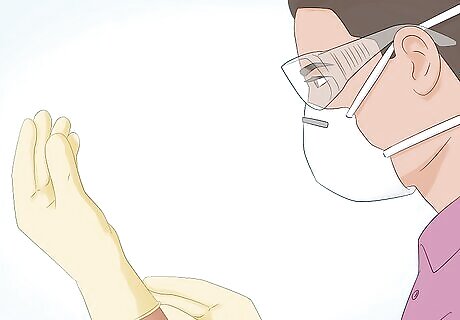
Battery leaks can contain caustic chemicals that irritate the skin, lungs, and eyes. Automotive repair specialist Duston Maynes recommends wearing safety goggles, a face mask, and rubber, nitrile, or latex gloves before you handle the battery or the leaked material. Open all the windows and doors and use a fan to ensure the area is ventilated. If you get battery acid on your skin or in your eyes, rinse the area in lukewarm, gently flowing water for at least 30 minutes. Under running water, remove all contaminated clothing and accessories. Acid leaks, typically from a car battery, are much more dangerous than alkaline battery leaks.
Determine the battery type.
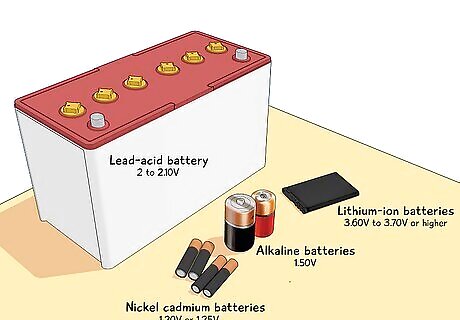
Most batteries for cars and other motor vehicles are lead-acid batteries. Smaller batteries that slot into electric devices are more varied, so examine the label to find the type. The most common types for small batteries are alkaline, lithium, and nickel-cadmium (NiCd). Size and shape alone are not reliable identification methods. If the only label is the voltage display (V), you can make an educated guess: Nickel cadmium (NiCd): 1.20V or 1.25V. Alkaline batteries: 1.50V. Lead-acid batteries: 2 to 2.10V. Lithium-ion batteries: 3.60V to 3.70V or higher.
Remove and dispose of the battery.
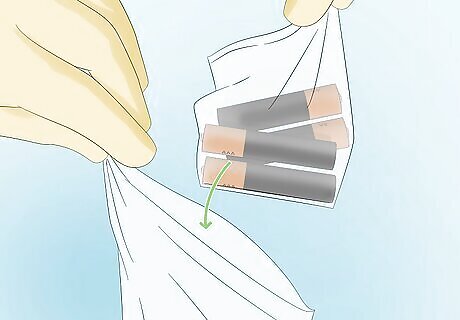
Double-bag small batteries separately in small plastic bags. Put car batteries and other large batteries inside two trash bags, ideally made from 6mm+ (0.2 in) thick polyethylene. Tie or seal the bag closed immediately. In some places, you can dispose of alkaline batteries in the trash, but most other batteries are required to be recycled by law. Visit earth911's online tool to find a nearby hardware store or other location that will recycle your type of battery. Lithium-ion batteries can explode or catch fire, so they cannot be placed in household garbage or recycling bins. Some battery manufacturers may offer you a free or reduced-price replacement battery in exchange.
Wipe up lithium spills with water.
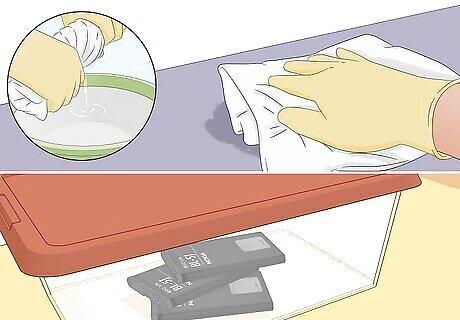
For lithium-ion batteries, like cell phone batteries or "button" batteries, place the bag in a non-metal, leak-proof container. Any electric device exposed to the leak is no longer safe to use. Throw the device away, and clean up spills with water and a soft cloth. If you have access to a lithium spill kit, neutralize the material with the absorbent material and neutralizing agent, put the absorbent into a sealable bag, and clean the area with water. Alternatively, clean the area with an ammonia-based cleaner.
Neutralize lead-acid or nickel-cadmium spills with baking soda.
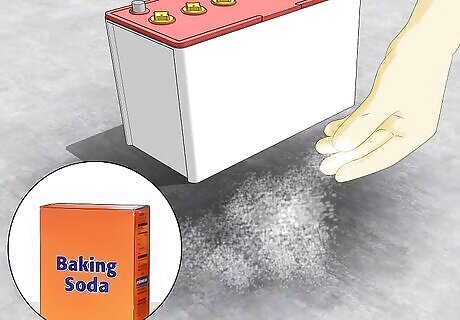
These types of batteries leak a strong acid, which can eat through clothing, carpet, or even metal. Cover the area liberally with baking soda. The acid is neutralized when the baking soda stops fizzing. Absorb the leftover material with clay or kitty litter and shovel it all into a doubled trash bag. If the battery is broken or damaged, sprinkle a liberal amount of baking soda inside the double bag containing it. If there’s acid on surfaces around the battery, you may need to use a wire brush to scrub it off. Use an absorbent microfiber cloth to dry the area once the corrosion is gone. Make sure you have gloves and a face mask on before tackling one of these spills.
Clean up alkaline spills with mild household acid.

For alkaline batteries, dip a cotton swab in vinegar or lemon juice and apply a few drops to the affected area. Use a cotton swab dipped in 90 to 99% isopropyl alcohol to remove residue. Wipe the area with a microfiber cloth, then let the device dry for several hours. Although the potassium hydroxide that leaks from alkaline batteries is often called “battery acid,” it’s actually a base on the pH scale, meaning it’s best neutralized with an acid. Use a toothbrush or toothpick to scrape off lingering corrosion in the battery compartment and contacts. For heavy corrosion, use fine sandpaper, an emery board, or a small screwdriver to gently scrape off the residue.



















Comments
0 comment